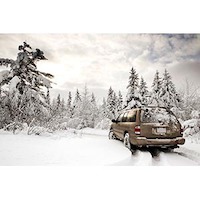Explore these cold, hard facts about wintertime.
The winter solstice marks the first day of winter. For people residing in the Northern Hemisphere, Tuesday, December 21, 2021, heralds the official arrival of winter (the Southern Hemisphere's winter solstice is on Sunday, June 20).
Though it's common to think of the winter solstice as an event that spans an entire day, it actually occurs for just a moment - specifically when a hemisphere is tilted as far away from the sun as it can be.
Winter is widely known as the coldest time of the year in most locales, but that's not the only thing that makes the season unique. Explore these other cold, hard facts about wintertime.
· The Earth actually is closest to the sun in December, even though the winter solstice is the shortest day of the year. The amount of daylight hours has to do with the tilt of the Earth on its axis rather than its proximity to the sun.
· The Southern Hemisphere, due to having less land mass and a more maritime climate, tends to have milder winters than the Northern Hemisphere.
· According to Smithsonian, ancient Romans used daylight and darkness to determine the time. As a result, an hour in ancient Rome lasted 45 minutes in the winter and 75 minutes in the summer.
· Two islands, called Big Diomede and Little Diomede, are located in the Bering Strait, which divides Alaska from Russia. Big Diomede is owned by Russia, while Little Diomede is owned by the United States. The 2.5 mile stretch between these two islands often freezes over in winter, technically making it possible to walk from the U.S. to Russia, according to Alaska Centers Public Land Information.
· Snow is common in many areas during the winter. The highest snowfall ever recorded in a one-year period in the U.S. occurred at Mount Rainier, in Washington. Between February 19, 1971, and February 18, 1972, 31.1 meters (1,224 inches) of snow fell.
· Russia remains the coldest country in the world during the winter. Canada and Mongolia are not too far behind.
· The largest snowflake ever recorded measured 15 inches wide. It was found in Fort Keogh, Montana.
· A city in Sweden uses light therapy in bus stops to help combat seasonal affective disorder during winter, when 19 hours of darkness are common.
· Unlike hurricanes and other summer storms, winter storms are not named by the National Weather Service.
· Snowflakes are translucent, not white.
· No country in the Southern Hemisphere has hosted or applied to host the Winter Olympics.
· Most weather-related crashes in the U.S. happen on wet pavement during rainfall rather than during snow or sleet, according to the U.S. Department of Transportation.
Winter might be seen as a cold period marked by dark days. But there's still a lot of interesting things going on between the winter solstice and the spring equinox.




